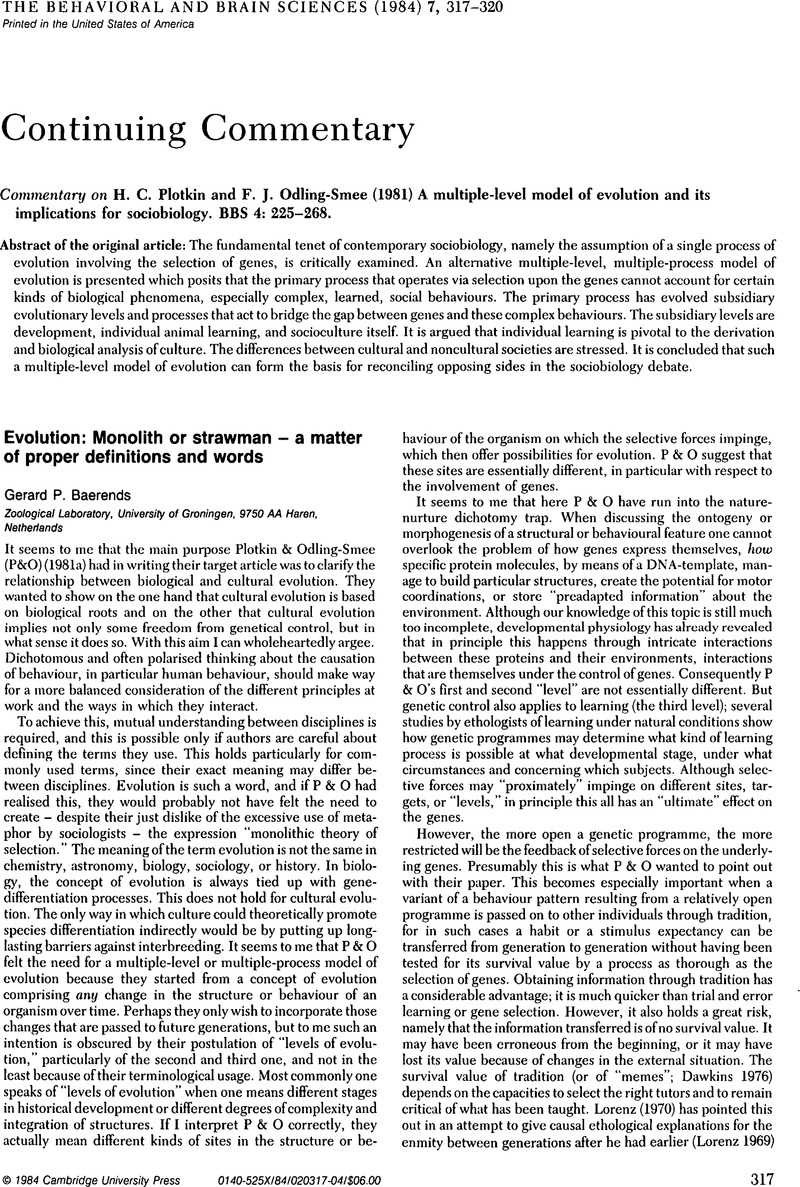Crossref Citations
This article has been cited by the following publications. This list is generated based on data provided by Crossref.
Campbell, Donald T.
Heyes, Cecilia M.
and
Callebaut, Werner G.
1987.
Evolutionary Epistemology.
p.
405.
Smith, J. David
1990.
Are species intelligent? Look for genetic knowledge structures.
Behavioral and Brain Sciences,
Vol. 13,
Issue. 1,
p.
89.
Hendersen, Robert W.
1990.
Species intelligence: Hazards of structural parallels.
Behavioral and Brain Sciences,
Vol. 13,
Issue. 1,
p.
78.
Salthe, Stanley N.
1990.
Misplaced predicates and misconstrued intelligence.
Behavioral and Brain Sciences,
Vol. 13,
Issue. 1,
p.
86.
Schull, Jonathan
1990.
Are species intelligent?.
Behavioral and Brain Sciences,
Vol. 13,
Issue. 1,
p.
63.
Silverstein, Albert
1990.
Natural teleology and species intelligence.
Behavioral and Brain Sciences,
Vol. 13,
Issue. 1,
p.
87.
Sternberg, Robert J.
1990.
Of cockroaches as kings.
Behavioral and Brain Sciences,
Vol. 13,
Issue. 1,
p.
91.
Strong, Gary W.
1990.
Neo-Lamarckism, or, The rediscovery of culture.
Behavioral and Brain Sciences,
Vol. 13,
Issue. 1,
p.
92.
Leiser, David
1990.
Evolution, development, and learning in cognitive science.
Behavioral and Brain Sciences,
Vol. 13,
Issue. 1,
p.
80.
Sumida, B. H.
1990.
Effective search using Sewall Wright's shifting balance hypothesis.
Behavioral and Brain Sciences,
Vol. 13,
Issue. 1,
p.
93.
Johnson, Mark H.
1990.
Similarities and dissimilarities between adaptation and learning.
Behavioral and Brain Sciences,
Vol. 13,
Issue. 1,
p.
79.
Clayton, Philip
1990.
The ontology of “intelligent species”.
Behavioral and Brain Sciences,
Vol. 13,
Issue. 1,
p.
75.
Lloyd, Elisabeth A.
1990.
“Intelligent” evolution and neo-Darwinian straw men.
Behavioral and Brain Sciences,
Vol. 13,
Issue. 1,
p.
81.
MacKay, William A.
1990.
The way of all matter.
Behavioral and Brain Sciences,
Vol. 13,
Issue. 1,
p.
82.
Dennett, Daniel C.
1990.
Teaching an old dog new tricks.
Behavioral and Brain Sciences,
Vol. 13,
Issue. 1,
p.
76.
Derrickson, Kim C.
and
Greenberg, Russell S.
1990.
Unfortunately, scale and time matter.
Behavioral and Brain Sciences,
Vol. 13,
Issue. 1,
p.
77.
Piattelli-Palmarini, Massimo
1990.
Which came first, the egg-problem or the hen-solution?.
Behavioral and Brain Sciences,
Vol. 13,
Issue. 1,
p.
84.
Odling-Smee, F. J.
1990.
Biotic intelligence (BI)?.
Behavioral and Brain Sciences,
Vol. 13,
Issue. 1,
p.
83.
Sterelny, Kim
1990.
Learning, selection, and species.
Behavioral and Brain Sciences,
Vol. 13,
Issue. 1,
p.
90.
Ghiselin, Michael T.
1990.
Are libraries intelligent?.
Behavioral and Brain Sciences,
Vol. 13,
Issue. 1,
p.
78.



